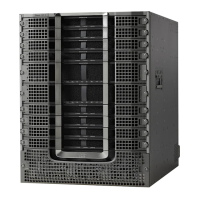modems on the same upstream channel can benefit from the advanced scheduling mechanisms and a DOCSIS
1.1 CMTS can still adequately support voice traffic from DOCSIS 1.1 cable modems with DOCSIS 1.0 cable
modems on the same upstream channel.
Provisioning
The format and content of the TFTP configuration file for a DOCSIS 1.1 cable modem are significantly
different from the file for a DOCSIS 1.0 cable modem. A dual-mode configuration file editor is used to
generate a DOCSIS 1.0 style configuration file for DOCSIS 1.0 cable modems and a DOCSIS 1.1 configuration
file for DOCSIS 1.1 cable modems.
Registration
A DOCSIS 1.1 CMTS must handle the existing registration Type/Length/Value parameters from DOCSIS
1.0 cable modems as well as the new type TLVs from DOCSIS 1.1 cable modems. A DOCSIS 1.0 and DOCSIS
1.1 cable modem can successfully register with the same DOCSIS 1.1 CMTS.
A DOCSIS 1.1 cable modem can be configured to make an indirect reference to a service class that has been
statically defined at the CMTS instead of explicitly asking for the service class parameters. When this
registration request is received by a DOCSIS 1.1 CMTS, it encodes the actual parameters of the service class
in the registration response and expects a DOCSIS 1.1-specific registration-acknowledge MAC message from
the cable modem.
When a DOCSIS 1.0 cable modem registers with a DOCSIS 1.1 CMTS, the registration request explicitly
requests all nondefault service-class parameters in the registration. The absence of an indirect service class
reference eliminates the need for the DOCSIS 1.1 TLVs and eliminates the need to establish a local registration
acknowledge wait state.
When a DOCSIS 1.1 CMTS receives a registration request from a DOCSIS 1.0 cable modem, it responds
with the DOCSIS 1.0 style registration response and does not expect the cable modem to send the
registration-acknowledge MAC message.
Information about DOCSIS 1.1
DOCSIS 1.1 is the first major revision of the initial DOCSIS 1.0 standard for cable networks. Although the
initial standard provided quality data traffic over the coaxial cable network, the demands of real-time traffic
such as voice and video required many changes to the DOCSIS specification.
The DOCSIS 1.1 specification provides the following feature enhancements over DOCSIS 1.0 networks:
Baseline Privacy Interface Plus
DOCSIS 1.0 introduced a Baseline Privacy Interface (BPI) to protect user data privacy across the shared-medium
cable network and to prevent unauthorized access to DOCSIS-based data transport services across the cable
network. BPI encrypts traffic across the RF interface between the cable modem and CMTS, and also includes
authentication, authorization, and accounting (AAA) features.
BPI supports access control lists (ACLs), tunnels, filtering, protection against spoofing, and commands to
configure source IP filtering on RF subnets to prevent subscribers from using source IP addresses that are not
valid. DOCSIS 1.1 enhances these security features with BPI Plus (BPI+), which includes the following
enhancements:
Cisco cBR Series Converged Broadband Routers Quality of Services Configuration Guide for Cisco IOS XE Fuji
16.7.x
35
DOCSIS 1.1 for the Cisco CMTS Routers
Information about DOCSIS 1.1

